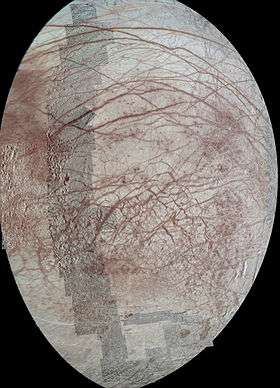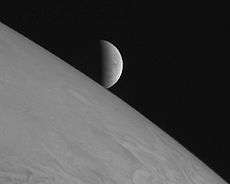Planetary Science Decadal Survey
 New Frontiers in the Solar System: An Integrated Exploration Strategy 2003–2013 | |
|
| |
| Author | National Academy Space Studies Board |
|---|---|
| Original title | New Frontiers in the Solar System: An Integrated Exploration Strategy 2003–2013 |
| Country | United States |
| Language | English |
| Genre | Astronomy |
| Publisher | United States National Research Council |
| Published | March 7, 2011 |
| Media type | hardcover, PDF |
The Planetary Science Decadal Survey is a publication of the United States National Research Council produced for NASA and other United States Government Agencies such as the National Science Foundation.[1] The document identifies key questions facing planetary science and outlines recommendations for space and ground-based exploration ten years into the future. Missions to gather data to answer these big questions are described and prioritized, where appropriate.[2][3][4]
Another major purpose of the program is to maintain an overall balance to space exploration, where, at a given year the focus may shift to one target of interest, over time-scales of 10 to 15 years the general direction and scope of the programs goes in the desired way.[5]
2013–2022, Visions and Voyages for Planetary Science
Visions and Voyages for Planetary Science in the Decade 2013 – 2022 (2011) was published in prepublication form on March 7, 2011,[4] and in final form later that year.[1] Draft versions of the document were presented at town hall meetings around the country, at lunar and planetary conferences, and made available publicly on the NASA website and via the National Academies Press.[4] The report differed from previous reports in that it included "brutally honest" budgetary review from a 3rd party contractor.
The report highlighted a new Mars rover, a mission to Jupiter's moon Europa, and a mission to Uranus and its moons as proposed Flagship Missions.[6] The Mars mission was given highest priority, followed by the Europa mission.[7] The Mars rover proposal was called MAX-C and it would store samples for eventual return to Earth, but the method of return was left open.[6] It only recommended the rover mission if it could be done cheaply enough (2.5 billion USD).[6]
The committee producing the survey was led by Steve Squyres of Cornell University and included 5 panels focusing on the inner planets (Mercury, Venus, and the Moon), Mars (not including Phobos and Deimos), the gas giant planets, satellites (Galilean satellites, Titan, and other satellites of the giant planets) and primitive bodies (Asteroids, comets, Phobos, Deimos, Pluto/Charon and other Kuiper belt objects, meteorites, and interplanetary dust).[8]

Mission & Technology Studies:[9]
- Mercury Lander Mission Concept Study
- Venus Mobile Explorer Mission Concept Study
- Venus Intrepid Tessera Lander Concept Study
- Venus Climate Mission Concept Study
- Lunar Geophysical Network Concept Study
- Lunar Polar Volatiles Explorer Mission Concept Study
- Near Earth Asteroid Trajectory Opportunities in 2020–2024
- Mars 2018 MAX-C Caching Rover Concept Study
- Mars Sample Return Orbiter Mission Concept Study
- Mars Sample Return Lander Mission Concept Study
- Mars 2018 Sky Crane Capability Study
- Mars Geophysical Network Options
- Mars Geophysical Network Concept Study
- Mars Polar Climate Concepts
- Jupiter Europa Orbiter (component of EJSM) Concept Study
- Io Observer Concept Study
- Ganymede Orbiter Concept Study
- Trojan Tour Concept Study
- Titan Saturn System Mission
- Saturn Atmospheric Entry Probe Trade Study
- Saturn Atmospheric Entry Probe Mission Concept Study
- Saturn Ring Observer Concept Study
- Enceladus Flyby & Sample Return Concept Studies
- Enceladus Orbiter Concept Study
- Titan Lake Probe Concept Study
- Chiron Orbiter Mission Concept Study
- Uranus and Neptune Orbiter and Probe Concept Studies
- Neptune-Triton-Kuiper Belt Objects Mission Concept Study
- Comet Surface Sample Return Mission Concept Study
- Cryogenic Comet Nucleus Sample Return Mission Technology Study
- Small Fission Power System Feasibility Study
The recommendation for the New Frontiers program was a selection from one of Comet Surface Sample Return, Lunar South Pole-Aitken Basin Sample Return, Saturn Probe, Trojan Tour and Rendezvous, and Venus In Situ Explorer.[10] Then another selection adding Io Observer, Lunar Geophysical Network.[10] (for NF 4 and 5)[10] In the 2011 response from NASA to the review, NASA supported the New Frontiers recommendations.[11] (The first three New Frontiers missions include New Horizons to Pluto flyby, the Juno Jupiter orbiter, and the OSIRIS-REx NEO sample return mission.)
For the astrophysics review see Astronomy and Astrophysics Decadal Survey.
Earlier NASA Planetary Science Surveys and studies of direction
2003–2013, New Frontiers in the Solar System

The previous study, New Frontiers in the Solar System: An Integrated Exploration Strategy 2003–2013 was published by the National Academies Press, in 2003.[12] The committee producing the survey was led by Michael J. Belton. The 5 panels focused on the inner planets, Mars, the Giant planets, Large satellites and Astrobiology. The survey placed heavy emphasis on Mars exploration including the Mars Exploration Rovers, established of the New Frontiers program including New Horizons mission to study Pluto and established programs in power and propulsion to lay a technological basis for programs in later decades including manned missions beyond Earth orbit.
1995 to 2015, Space Science in the Twenty-First Century, Imperatives for the Decades
While not titled as a decadal survey, a planetary science plan covering 1995–2015 was published by the Space Studies Board. The report recommended a focus on "Galileo-like missions to study Saturn, Uranus and Neptune" including a mission to rendezvous with Saturn's rings and study of Titan. It also recommended study of the moon with a "Lunar Geoscience Orbiter", a network of lunar rovers and sample return from the lunar surface. The report recommended a Mercury Orbiter to study not only that planet but provide some solar study as well. A "Program of Extensive Study of Mars" beginning with Mars Pathfinder mission was planned for 1995 to be followed up by one in 1998 to return samples to Earth for study. Study of primitive bodies such a comet or asteroid was recommended as a flyby mission of Apollo and Amor asteroid.[13]
1986–1996, A Strategy for Exploration of the Outer Planets

The studied note the success of the last goals, the exploration of the outer planets especially Jupiter and Saturn, but noted the lack of exploration of smaller bodies like asteroids and comets.[5]
1980–1990, Strategy for Exploration of Primitive Solar-System Bodies
1977–1987, Strategy for Exploration of the Inner Planets
While not a decadal survey, the 1975 Report of Space Science included the exploration of the Outer planets. [15]
1968–1975, Planetary Exploration
Published in the summer of 1968, it reviewed past and present understanding of the Solar System and recommended several new missions.[16] The following targets were given priority:[16]
1965, Wood's Hole Study

In the summer of 1965 the Space Science Board reviewed lunar and planetary science opportunities.[16] Space exploration, astronomy, and the humans in space were major topics.[17] These meetings brought together major ideas like the Grand tour, study of the outer planets and sun, and large space telescopes and there additional Woods hole meetings in 1969 and 1970 that influenced some of the large projects of the 1970s.[18] This study also showed signs of how the scientific community began to siphon the public's excitement about the manned exploration of space into more eccentric scientific projects, marking a shift from a more supportive role to actually taking the place of manned exploration.[19] The study marked a distinction between manned and unmanned missions, laying the foundation for a collision between two concepts in which scientists would explore the solar system from Earth using unmanned vehicles because that, rather than human exploration as an end in and of itself supported by science.[19] Without boots on the ground public interest collapsed leaving astronauts purpose to be doing even more science experiments.[19]
See also
References
- 1 2 National Academy of Sciences, National Academies Press, http://www.nap.edu/download.php?record_id=13117 , Vision and Voyages for Planetary Science in the Decade 2013–2022, 2011; ISBN 978-0-309-22464-2. Retrieved February 23, 2015
- ↑ "STATEMENT OF TASK" (PDF). Planetary Science Decadal Survey: 2013-2022.
- ↑ "What is the Decadal Survey". Planetary Society. Archived from the original on 2015-03-20. Retrieved 22 Feb 2015.
- 1 2 3 "2013 Decadal Survey and NASA Planetary Science (Prepublication version)". NASA. Retrieved 22 Feb 2015.
- 1 2 3 4 A Strategy for Exploration of the Outer Planets, 1986–1996. Space Studies Board. 1980. ISBN 0-309-12336-4.
- 1 2 3 "Lean U.S. missions to Mars, Jupiter moon recommended". 7 March 2011. Reuters. 8 March 2011.
- ↑ http://www.livestream.com/2011lpsc/video?clipId=pla_18e48f98-4a78-4acc-ad2a-29c7a8ae326c
- ↑ Sayanagi, Kunio M. (March 14, 2011). "Planetary Exploration 2013–2022: Scientists are ready, what about you?". ArsTechnica. Retrieved March 21, 2011.
- ↑ Planetary Science Decadal Survey Mission & Technology Studies
- 1 2 3 "Decadal Executive Summary" (PDF). Retrieved 30 December 2017.
- ↑ Kennel, Charles (July 29, 2011). "Planetary Science Division Response to the Planetary Science Decadal Survey" (PDF). Retrieved 30 December 2017.
- ↑ New Frontiers in the Solar System: An Integrated Exploration Strategy 2003–2013, National Academies Press
- ↑ Space Science in the Twenty-First Century – Imperatives for the Decades 1995 to 2015. Space Studies Board. 1988. ISBN 978-0-309-03885-0.
- ↑ A Strategy for Exploration of the Inner Planets, 1977–1987. Space Studies Board. 1977. ISBN 0-309-12343-7.
- ↑ Report on Space Science. Space Studies Board. 1976. ISBN 0-309-12347-X.
- 1 2 3 Report on Space Science. Space Studies Board. 1968. OCLC 254442711.
- ↑ Chapter 3 of NASA SP-4214
- ↑ Butrica, Andrew J. "Voyager: The Grand Tour of Big Science". history.nasa.gov. Retrieved 30 December 2017.
- 1 2 3 "Where No Man Has Gone Before, Ch3-6". www.hq.nasa.gov. Retrieved 30 December 2017.